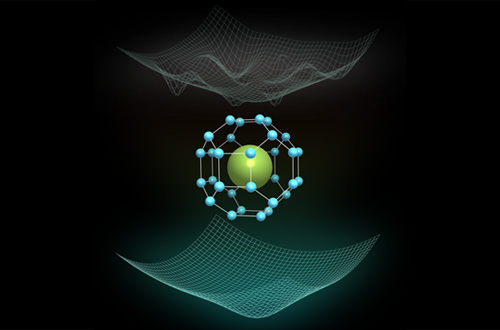Record Superconductor LaH10 Sustained by Atomic Quantum Fluctuations
—New theoretical prediction suggests that the superconductivity approaching room temperature may be possible at much lower pressures than previously expected with classical calculations—
2020.02.06
National Institute for Materials Science (NIMS)
Tohoku University
University of Tokyo
RIKEN
Calculations performed by an international team of researchers from NIMS, Tohoku University, the University of Tokyo, RIKEN, and others show that the record-superconducting lanthanum hydride LaH10 is stabilized by the atomic quantum fluctuations. This discovery indicates that hydrogen-rich compounds have the potential to exhibit high-temperature and even room-temperature superconductivity at much lower pressures than previously expected with classical calculations.
Abstract
- Calculations performed by an international team of researchers from NIMS, Tohoku University, the University of Tokyo, RIKEN, and others show that the record-superconducting lanthanum hydride LaH10 is stabilized by the atomic quantum fluctuations. This discovery indicates that hydrogen-rich compounds have the potential to exhibit high-temperature and even room-temperature superconductivity at much lower pressures than previously expected with classical calculations.
- Superconducting materials are capable of conducting electricity without resistance or energy loss and, therefore, are expected to solve environmental and energy issues. Humankind has long dreamt of the development of room-temperature superconductors, and a considerable amount of research has been conducted on this subject. Research published in 2019 reported that a lanthanum hydride (LaH10) exhibits superconductivity at near room temperature (250 K or -23°C) under high pressure (130–220 GPa), breaking the previous record for the highest superconducting critical temperature. The cubic crystalline structure of LaH10, which is responsible for the high-temperature superconductivity, was found to be stable at a wide range of pressures between 130 and 220 GPa. However, previous theoretical calculations predicted that at least 230 GPa of pressure would be necessary for stabilizing the cubic structure. Since then, the physical mechanism that stabilizes the cubic LaH10 at a pressure 100 GPa lower than the previous prediction has attracted much attention.
- While atomic quantum fluctuations had been omitted in previous theoretical calculations, this research team focused on this effect and performed computer simulations taking it into account. As a result, the team found that when LaH10 is subjected to high pressures, its hydrogen nuclei experience extremely large quantum fluctuations. Cubic LaH10 is therefore in a quantum-solid state, in which its crystalline structure remains stable under a wide range of pressures due to the quantum fluctuation effect. By using the theoretical method that can treat the atomic quantum fluctuations accurately, the team also reproduced the experimental superconducting critical temperatures successfully, including their pressure dependence.
- The quantum fluctuation of atomic nuclei is a common phenomenon that occurs in many materials. Hydrogen-rich compounds other than LaH10 are currently being investigated that may have superconducting critical temperatures exceeding the record achieved by LaH10 under high pressure. By accounting for the quantum fluctuation effect, our simulation technique enables a more accurate theoretical prediction of the compositions and structures of these potentially promising materials. In future research, we will apply our theoretical method to a wider range of materials and aim to design room-temperature superconducting materials.
- This project was carried out by an international research team led by the following researchers: Terumasa Tadano (Researcher, Research Center for Magnetic and Spintronic Materials, NIMS), Takashi Koretsune (Associate Professor, Department of Physics, Tohoku University), Ryotaro Arita (Professor, Department of Applied Physics, University of Tokyo; also the Leader of the First-principles Materials Science Research Team, RIKEN Center for Emergent Matter Science), Ion Errea (University of the Basque), Antonio Sanna (Max Planck Institute of Microstructure Physics), Matteo Calandra (Sorbonne University), Francesco Mauri (Professor, Sapienza University of Rome) and José A. Flores-Livas (Sapienza University of Rome).
Part of this project was conducted in conjunction with other projects funded by the Grant-in-Aid for Scientific Research entitled “Materials design and exploration of functions for strongly correlated materials: challenges to non-equilibrium and non-periodic systems (project number: 16H06345),” “Exploration of superconducting materials by multifaceted approaches based on first-principles calculation (project number: 18K03442)” and “Development of theories for quantum liquid crystals (project number: 19H05825).” - This research was published in the online version of Nature at 6:00 pm on February 5, 2020, local time (3:00 am on February 6, Japan Time).

Figure. Schematic diagram showing the crystalline structure of cubic LaH10 and its potential energy surfaces
Related files
- Research Center for Magnetic and Spintronic Materials
Contacts
(Regarding this research)
-
Terumasa Tadano,
Researcher,
Spin Theory Group,
Research Center for Magnetic and Spintronic Materials,
National Institute for Materials Science (NIMS)
Tel: +81-859-2332
E-Mail: Tadano.Terumasa=nims.go.jp
(Please change "=" to "@") -
Takashi Koretsune
Associate Professor, Department of Physics
Tohoku University
E-Mail: koretsune=cmpt.phys.tohoku.ac.jp
(Please change "=" to "@") -
Ryotaro Arita
Professor, Department of Applied Physics
University of Tokyo
Leader of the First-principles Materials Science Research Team
RIKEN Center for Emergent Matter Science
E-Mail: arita=ap.t.u-tokyo.ac.jp
(Please change "=" to "@")
(General information)
-
Public Relations Office
National Institute for Materials Sciences
Tel: +81-29-859-2026
Fax: +81-29-859-2017
E-Mail: pressrelease=ml.nims.go.jp
(Please change "=" to "@") -
PR and Outreach Office
Graduate School of Science
Tohoku University
6-3 Aoba, Aramaki, Aoba-ku, Sendai 980-8578, Japan
Tel: +81-22-795-6708
Fax: +81-22-795-5831
E-Mail: sci-pr=mail.sci.tohoku.ac.jp
(Please change "=" to "@") -
Public Relations Office
RIKEN
2-1 Hirosawa, Wako, Saitama 351-0198, Japan
Tel: +81-48-467-9272
Fax: +81-48-462-4715
E-Mail: ex-press=riken.jp
(Please change "=" to "@") -
Public Relations Office
School of Engineering
University of Tokyo
7-3-1 Hongo, Bunkyo-ku, Tokyo 113-8656, Japan
Tel: +81-3-5841-6295
E-Mail: kouhou=pr.t.u-tokyo.ac.jp
(Please change "=" to "@")
Recent Press Release
-
Simultaneous Imaging of Intracellular DNA and RNA Using Harmless Light
2025.10.27
-
Development of an AI Device Using Ion Gel and Graphene That Dramatically Streamlines Machine Learning Computations
2025.10.14
-
Demonstrating a Novel Method to Modulate Heat Flow Through the Collective Motion of Spins
2025.10.06
